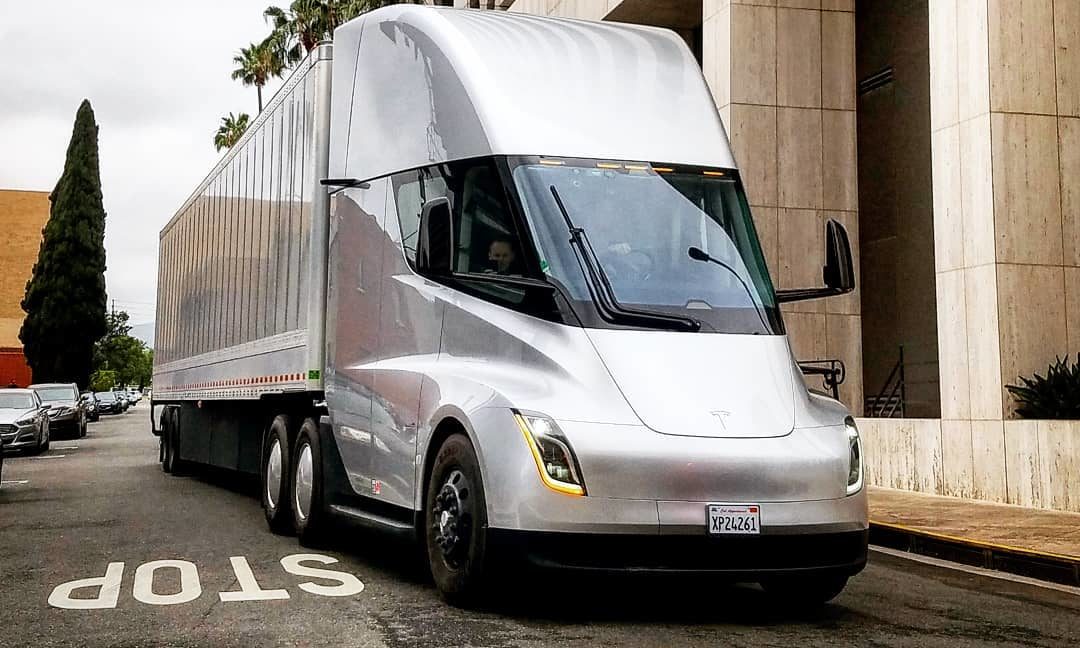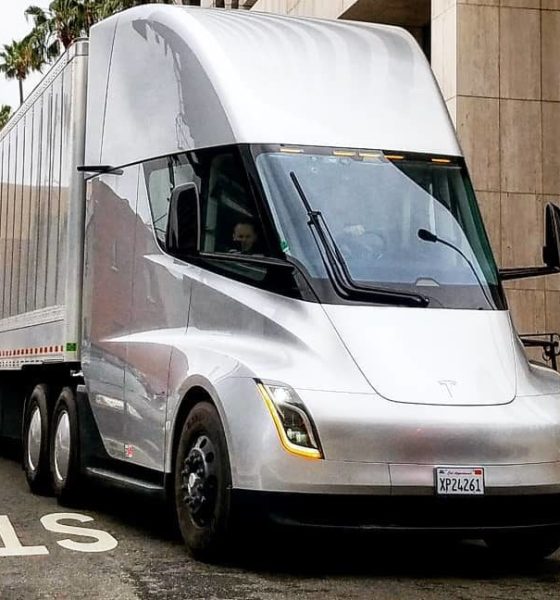

News
Tesla Semi rival Daimler on electric trucks: ‘The best battery solution is going to win’
Amidst the emergence of all-electric long-haulers like the Tesla Semi, an established brand is adopting an optimistic stance about the trucking industry’s upcoming electrification. During a recent media roundtable at the American Trucking Associations’ annual Management Conference & Exhibition, CEO of Daimler Trucks North America Roger Nielsen stated that the industry’s transition towards electrification is happening at a “greater speed than expected.”
Daimler is no stranger to the idea of using electric trucks as a viable alternative to diesel-powered vehicles. Last June, Daimler took the wraps off the all-electric Freightliner eCascadia heavy-duty, which has a range of 250 miles per charge and the capability to be charged to 80% in 90 minutes. The company also unveiled the mid-duty Freightliner eM2, which offers a 230-mile range and the ability to recharge 80% of its battery in 60 minutes.

Tesla has not released the actual specs of its battery for the Semi, though Elon Musk noted that the company would be launching two versions of the vehicle — a 500-mile long range variant and a 300-mile short range version. Musk’s later statements teased improvements to the Semi’s range as well, with the CEO stating that the vehicle would likely have closer to 600 miles of range per charge. When asked by reporters about his stance on the Tesla Semi, Nielsen noted that battery quality and energy consumption would be the determining factor in the emerging electric truck market.
“The best battery solution is going to win. It’s all about energy consumption,” he said, according to Fleet Owner.
That said, the Daimler executive remains optimistic about the German legacy carmaker’s chances in the electric truck industry. Nielsen, for one, noted that he believes Daimler would have the highest number of electric trucks in the commercial trucking segment by 2020. Apart from this, Nielsen also stated that Daimler’s offerings could have an edge against the Tesla Semi, since customers would likely opt for electric vehicles that are similar to trucks they are already familiar with. With this in mind, Nielsen believes that the Freightliner eCascadia and the eM2 would probably perform very well.
“That helps create a smooth transition from a diesel-powered truck to an electric-powered truck,” Nielsen said.
While the Tesla Semi is yet to enter production, the all-electric long-hauler has the potential to be a serious disruptor in the trucking industry. The vehicle’s range and performance, coupled with the support of the upcoming Megacharger Network, would allow the vehicle to be competitive even against diesel-powered semi-trailers. Tesla is also in the process of improving the Semi, as noted by the company’s President of Automotive Jerome Guillen during the second quarter earnings call.
“Obviously, it’s going to be better than what we showed last year. There is a lot of improvements,” he said.
Tesla has so far been tight-lipped about the Semi’s improvements since its launch last year, though recently published patents have teased a number of compelling features that might make it to the vehicle. Last month, for example, a patent for an automatic tire inflation system for the Semi was published. While the ATIS would likely be used initially for the Semi, the feature could pave the way for the off-road capabilities of Tesla’s other vehicles, such as the Tesla pickup truck, the Model Y, and the Model X.

News
Elon Musk’s Grok AI to be used in U.S. War Department’s bespoke AI platform
The partnership aims to provide advanced capabilities to 3 million military and civilian personnel.

The U.S. Department of War announced Monday an agreement with Elon Musk’s xAI to embed the company’s frontier artificial intelligence systems, powered by the Grok family of models, into the department’s bespoke AI platform GenAI.mil.
The partnership aims to provide advanced capabilities to 3 million military and civilian personnel, with initial deployment targeted for early 2026 at Impact Level 5 (IL5) for secure handling of Controlled Unclassified Information.
xAI Integration
As noted by the War Department’s press release, GenAI.mil, its bespoke AI platform, will gain xAI for the Government’s suite of tools, which enable real-time global insights from the X platform for “decisive information advantage.” The rollout builds on xAI’s July launch of products for U.S. government customers, including federal, state, local, and national security use cases.
“Targeted for initial deployment in early 2026, this integration will allow all military and civilian personnel to use xAI’s capabilities at Impact Level 5 (IL5), enabling the secure handling of Controlled Unclassified Information (CUI) in daily workflows. Users will also gain access to real‑time global insights from the X platform, providing War Department personnel with a decisive information advantage,” the Department of War wrote in a press release.
Strategic advantages
The deal marks another step in the Department of War’s efforts to use cutting-edge AI in its operations. xAI, for its part, highlighted that its tools can support administrative tasks at the federal, state and local levels, as well as “critical mission use cases” at the front line of military operations.
“The War Department will continue scaling an AI ecosystem built for speed, security, and decision superiority. Newly IL5-certified capabilities will empower every aspect of the Department’s workforce, turning AI into a daily operational asset. This announcement marks another milestone in America’s AI revolution, and the War Department is driving that momentum forward,” the War Department noted.
News
Tesla FSD (Supervised) v14.2.2 starts rolling out
The update focuses on smoother real-world performance, better obstacle awareness, and precise end-of-trip routing, among other improvements.

Tesla has started rolling out Full Self-Driving (Supervised) v14.2.2, bringing further refinements to its most advanced driver-assist system. The new FSD update focuses on smoother real-world performance, better obstacle awareness, and precise end-of-trip routing, among other improvements.
Key FSD v14.2.2 improvements
As noted by Not a Tesla App, FSD v14.2.2 upgrades the vision encoder neural network with higher resolution features, enhancing detection of emergency vehicles, road obstacles, and human gestures. New Arrival Options let users select preferred drop-off styles, such as Parking Lot, Street, Driveway, Parking Garage, or Curbside, with the navigation pin automatically adjusting to the user’s ideal spot for precision.
Other additions include pulling over for emergency vehicles, real-time vision-based detours for blocked roads, improved gate and debris handling, and extreme Speed Profiles for customized driving styles. Reliability gains cover fault recovery, residue alerts on the windshield, and automatic narrow-field camera washing for new 2026 Model Y units.
FSD v14.2.2 also boosts unprotected turns, lane changes, cut-ins, and school bus scenarios, among other things. Tesla also noted that users’ FSD statistics will be saved under Controls > Autopilot, which should help drivers easily view how much they are using FSD in their daily drives.
Key FSD v14.2.2 release notes
Full Self-Driving (Supervised) v14.2.2 includes:
- Upgraded the neural network vision encoder, leveraging higher resolution features to further improve scenarios like handling emergency vehicles, obstacles on the road, and human gestures.
- Added Arrival Options for you to select where FSD should park: in a Parking Lot, on the Street, in a Driveway, in a Parking Garage, or at the Curbside.
- Added handling to pull over or yield for emergency vehicles (e.g. police cars, fire trucks, ambulances).
- Added navigation and routing into the vision-based neural network for real-time handling of blocked roads and detours.
- Added additional Speed Profile to further customize driving style preference.
- Improved handling for static and dynamic gates.
- Improved offsetting for road debris (e.g. tires, tree branches, boxes).
- Improve handling of several scenarios, including unprotected turns, lane changes, vehicle cut-ins, and school buses.
- Improved FSD’s ability to manage system faults and recover smoothly from degraded operation for enhanced reliability.
- Added alerting for residue build-up on interior windshield that may impact front camera visibility. If affected, visit Service for cleaning!
- Added automatic narrow field washing to provide rapid and efficient front camera self-cleaning, and optimize aerodynamics wash at higher vehicle speed.
- Camera visibility can lead to increased attention monitoring sensitivity.
Upcoming Improvements:
- Overall smoothness and sentience.
- Parking spot selection and parking quality.
News
Tesla is not sparing any expense in ensuring the Cybercab is safe
Images shared by the longtime watcher showed 16 Cybercab prototypes parked near Giga Texas’ dedicated crash test facility.

The Tesla Cybercab could very well be the safest taxi on the road when it is released and deployed for public use. This was, at least, hinted at by the intensive safety tests that Tesla seems to be putting the autonomous two-seater through at its Giga Texas crash test facility.
Intensive crash tests
As per recent images from longtime Giga Texas watcher and drone operator Joe Tegtmeyer, Tesla seems to be very busy crash testing Cybercab units. Images shared by the longtime watcher showed 16 Cybercab prototypes parked near Giga Texas’ dedicated crash test facility just before the holidays.
Tegtmeyer’s aerial photos showed the prototypes clustered outside the factory’s testing building. Some uncovered Cybercabs showed notable damage and one even had its airbags engaged. With Cybercab production expected to start in about 130 days, it appears that Tesla is very busy ensuring that its autonomous two-seater ends up becoming the safest taxi on public roads.
Prioritizing safety
With no human driver controls, the Cybercab demands exceptional active and passive safety systems to protect occupants in any scenario. Considering Tesla’s reputation, it is then understandable that the company seems to be sparing no expense in ensuring that the Cybercab is as safe as possible.
Tesla’s focus on safety was recently highlighted when the Cybertruck achieved a Top Safety Pick+ rating from the Insurance Institute for Highway Safety (IIHS). This was a notable victory for the Cybertruck as critics have long claimed that the vehicle will be one of, if not the, most unsafe truck on the road due to its appearance. The vehicle’s Top Safety Pick+ rating, if any, simply proved that Tesla never neglects to make its cars as safe as possible, and that definitely includes the Cybercab.








